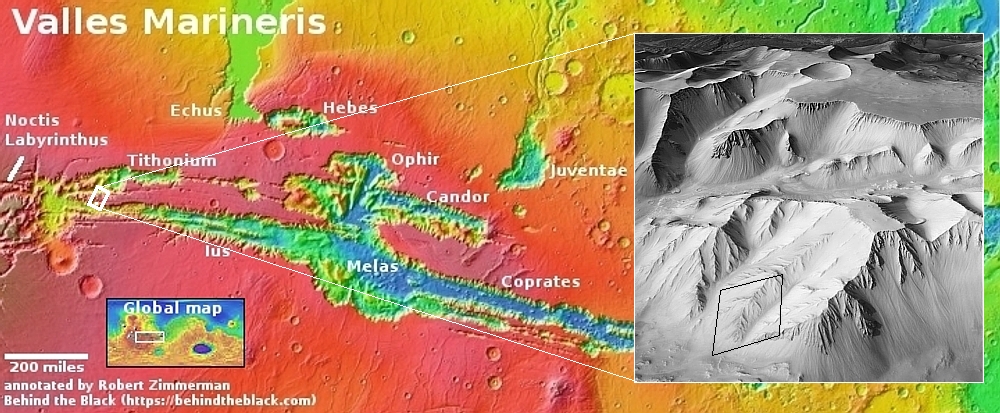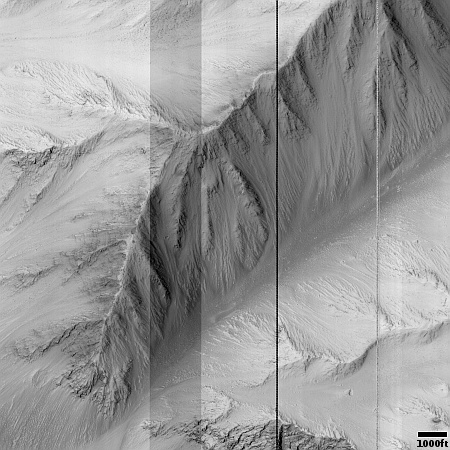Exploring the canyons and plateaus of Valles Marineris

Cool image time! The picture to the right, rotated, cropped, reduced, and sharpened to post here, was taken on November 2, 2024 by the high resolution camera on Mars Reconnaissance Orbiter (MRO). It shows just one small section of a ridge that descends deep into the giant canyon Valles Marineris, the largest known canyon in the solar system.
On the overview map above, the white dot inside the rectangle marks the location, in the westernmost section of the part of Valles Marineris dubbed Ius Chasma.
For scale, the nose of this ridge descends about 7,300 feet from the top to the bottom, about half the total descent from the small isolated plateau shown in the inset. That plateau, located in the mountainous region between Ius Chasma and Tithonium Chasma, rises to approximately the same elevation as the canyon’s rims to the north and south.
What this picture shows us is that Valles Marineris on its western end is both more shallow and broken up, forming several canyons and plateaus. As the catastrophic floods that are theorized to have carved this canyon pushed their way east, they carved a deeper gorge, so that about 1,500 miles to the east the canyon walls are considerable higher, from 20,000 to 30,000 feet in some places.
As always, the tourist in me can’t help look at this terrain and envision inns and hiking trails. Imagine homesteading that plateau where you build a hotel and trails. Since I expect much transportation on Mars will be by air, your guests would fly in, land at a heliport, and spend their visit hiking down into the canyons that surround them.
Damn! The future is going to so grand!
On Christmas Eve 1968 three Americans became the first humans to visit another world. What they did to celebrate was unexpected and profound, and will be remembered throughout all human history. Genesis: the Story of Apollo 8, Robert Zimmerman's classic history of humanity's first journey to another world, tells that story, and it is now available as both an ebook and an audiobook, both with a foreword by Valerie Anders and a new introduction by Robert Zimmerman.
The print edition can be purchased at Amazon or from any other book seller. If you want an autographed copy the price is $60 for the hardback and $45 for the paperback, plus $8 shipping for each. Go here for purchasing details. The ebook is available everywhere for $5.99 (before discount) at amazon, or direct from my ebook publisher, ebookit. If you buy it from ebookit you don't support the big tech companies and the author gets a bigger cut much sooner.
The audiobook is also available at all these vendors, and is also free with a 30-day trial membership to Audible.
"Not simply about one mission, [Genesis] is also the history of America's quest for the moon... Zimmerman has done a masterful job of tying disparate events together into a solid account of one of America's greatest human triumphs."--San Antonio Express-News

Cool image time! The picture to the right, rotated, cropped, reduced, and sharpened to post here, was taken on November 2, 2024 by the high resolution camera on Mars Reconnaissance Orbiter (MRO). It shows just one small section of a ridge that descends deep into the giant canyon Valles Marineris, the largest known canyon in the solar system.
On the overview map above, the white dot inside the rectangle marks the location, in the westernmost section of the part of Valles Marineris dubbed Ius Chasma.
For scale, the nose of this ridge descends about 7,300 feet from the top to the bottom, about half the total descent from the small isolated plateau shown in the inset. That plateau, located in the mountainous region between Ius Chasma and Tithonium Chasma, rises to approximately the same elevation as the canyon’s rims to the north and south.
What this picture shows us is that Valles Marineris on its western end is both more shallow and broken up, forming several canyons and plateaus. As the catastrophic floods that are theorized to have carved this canyon pushed their way east, they carved a deeper gorge, so that about 1,500 miles to the east the canyon walls are considerable higher, from 20,000 to 30,000 feet in some places.
As always, the tourist in me can’t help look at this terrain and envision inns and hiking trails. Imagine homesteading that plateau where you build a hotel and trails. Since I expect much transportation on Mars will be by air, your guests would fly in, land at a heliport, and spend their visit hiking down into the canyons that surround them.
Damn! The future is going to so grand!
On Christmas Eve 1968 three Americans became the first humans to visit another world. What they did to celebrate was unexpected and profound, and will be remembered throughout all human history. Genesis: the Story of Apollo 8, Robert Zimmerman's classic history of humanity's first journey to another world, tells that story, and it is now available as both an ebook and an audiobook, both with a foreword by Valerie Anders and a new introduction by Robert Zimmerman.
The print edition can be purchased at Amazon or from any other book seller. If you want an autographed copy the price is $60 for the hardback and $45 for the paperback, plus $8 shipping for each. Go here for purchasing details. The ebook is available everywhere for $5.99 (before discount) at amazon, or direct from my ebook publisher, ebookit. If you buy it from ebookit you don't support the big tech companies and the author gets a bigger cut much sooner.
The audiobook is also available at all these vendors, and is also free with a 30-day trial membership to Audible.
"Not simply about one mission, [Genesis] is also the history of America's quest for the moon... Zimmerman has done a masterful job of tying disparate events together into a solid account of one of America's greatest human triumphs."--San Antonio Express-News



I always thought the best target for colonization would be in here somewhere. All kinds of exposed minerals available, the highest atmospheric pressure, you could build into the cliffs and in the valleys you are semi-shielded from space radiation. Maybe you could even manufacture sulfur-hexafluoride to fill the lower reaches to create higher pressure and retain a bit of heat from the sunlight. Turn the whole valley into a giant oasis.